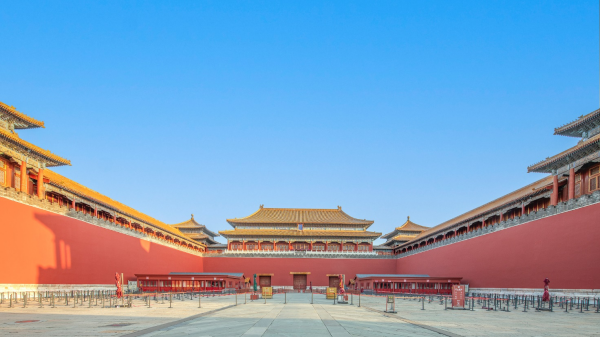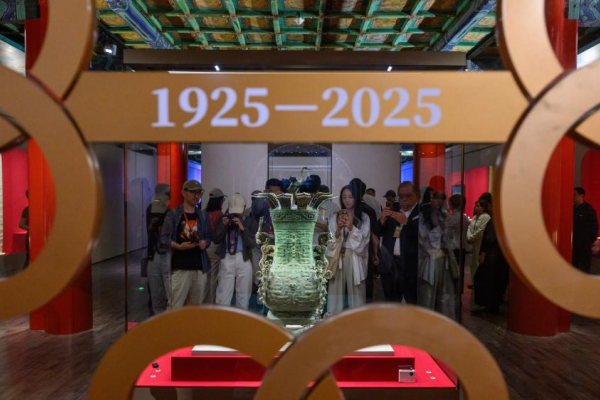


The Palace Museum at 100: From imperial court to global icon

The Palace Museum in Beijing, capital of China, October 2, 2025. /Xinhua
A century ago, what had been the heart of imperial China was reborn as something radically new. In 1925, the Forbidden City, once the exclusive domain of emperors, was transformed into the Palace Museum, a cultural institution dedicated to safeguarding treasures that had long symbolized dynastic power. What had for centuries stood as a walled-off seat of authority suddenly became open to the public. This was more than a change of function; it was a change of meaning. The Forbidden City became the shared inheritance of a nation and ultimately, of the world.
Now, as the Palace Museum in Beijing celebrates its 100th anniversary, it is a dynamic force shaping the future of culture. Its centennial is a reminder that heritage is not static: It evolves, adapts and continues to inspire across generations.
To step into the Palace Museum today is to encounter history on a monumental scale. Constructed in the early 15th century under the Ming Dynasty and serving as the home of emperors until the fall of the Qing Dynasty in 1911, the Forbidden City was not only the political center of the empire but also the spiritual core of the Chinese civilization.
For centuries, access to this site was restricted, its inner sanctums reserved for emperors, consorts and officials. To ordinary people, it was a world apart, shrouded in mystery. The transformation of this space into the Palace Museum represented a radical shift: The treasures of the emperors were no longer guarded secrets, but cultural assets to be studied, preserved and admired by the public.
The museum's founding mission was both straightforward and monumental: to preserve, study and share the unparalleled wealth of artifacts housed within the Forbidden City. Its collection spans thousands of years and countless forms including paintings, calligraphy, ceramics, bronzes, jades, textiles, books and everyday objects used by emperors and their courts. Each artifact embodies layers of cultural memory, bearing witness to the artistic brilliance and philosophical depth of China's dynasties.
Over the decades, generations of curators, conservators and scholars have not only safeguarded these objects but also given them new meaning. Through exhibitions, catalogues and educational programs, the Palace Museum has brought the past into dialogue with the present. What was once the preserve of an elite has become a shared cultural resource, accessible to millions of visitors each year.
This democratization of heritage mirrors China's own modern transformation. By opening the Forbidden City to the people, the Palace Museum symbolizes a broader cultural awakening: the idea that history and beauty belong to all.

Visitors view an exhibit at the Palace Museum in Beijing, capital of China, September 29, 2025. /Xinhua
Embracing its role as a bridge between civilizations, the Palace Museum has hosted international exhibitions that place Chinese masterpieces in conversation with works from ancient Egypt, Renaissance Europe and Japan. These encounters underscore the interconnectedness of human creativity and challenge the idea that cultures exist in isolation.
Conversely, exhibitions abroad have introduced the treasures of the Forbidden City to audiences worldwide. From Paris to New York, millions have encountered Chinese calligraphy, ceramics and imperial regalia firsthand. Each exhibition serves as cultural diplomacy in its most powerful form: Art as a language of connection, fostering respect and understanding across borders.
This dual role – welcoming the world to Beijing and sending Chinese culture abroad – has transformed the Palace Museum from a national treasure house into a global landmark. It demonstrates how heritage, when shared, becomes a force for dialogue in an often-divided world.
While rooted in tradition, the Palace Museum has not remained frozen in time. It has embraced technology as a tool for both preservation and engagement. Digital reconstructions bring lost buildings back to life, enabling visitors to imagine the Forbidden City as it once was. Virtual reality tours and interactive apps make the museum accessible to those unable to travel, extending its reach to millions worldwide.
For younger generations in particular, these innovations create new pathways into history. They experience dynamic storytelling, immersive reconstructions and interactive archives that make the past vivid and immediate.
Technology has revolutionized conservation. Fragile artifacts are now studied with advanced imaging and restored using precision techniques that preserve authenticity while ensuring longevity. Digital documentation secures permanent records of priceless works, ensuring they will never be lost, even to time. In this sense, the Palace Museum is both a guardian of the past and a laboratory for the future of museology.
The centenary of the Palace Museum is not only a moment of national pride for China but also an occasion of global relevance. It marks 100 years of transformation from the closed world of emperors to a vibrant public institution and from a national repository to an international platform.
Its anniversary invites reflection on what heritage means in the 21st century. The Palace Museum shows that culture is not about looking backward in nostalgia, but about sustaining a living conversation between past and future and between nations and peoples.
As the Palace Museum enters its second century, its influence is poised to grow. It will continue to serve as custodian of China's past, a stage for international cultural exchange and a pioneer in the digital future of museums. But perhaps its most enduring contribution lies in its ability to connect: To allow someone standing beneath the golden eaves of the Hall of Supreme Harmony, or another person exploring an online gallery thousands of miles away, to feel part of the same human story.
The Palace Museum at 100 is more than an institution marking a milestone. It is proof that when history is opened to all, it does not diminish, but multiplies. In its next century, the Palace Museum promises to inspire not only admiration for China's civilization, but also a deeper sense of humanity's shared heritage.
David Gosset is a specialist in global affairs and sinology and the founder of the China-Europe-America Global Initiative. One of his notable publications is an annual report on Chinese museums.
Editor:Yu Hui
Copyright©2023 CSSN All Rights Reserved